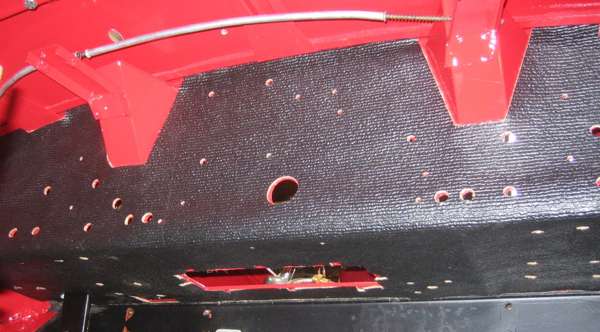The MGA With An Attitude
KEEPING The HEAT OUT and Sealing Bulkheads - INT-100
On 20 September 2006, Bill R of Westchester, PA wrote:
"Is there any significant value to the expensive insulating products for the bulkhead shelf and the underside of the carpet? Especially for just a Sunday drive".
After which John B wrote:
"I find that the majority of the heat comes from the fresh air vent even when closed. I don't have any issues with burning floorboards or other such myths. If it gets that hot then there must be something wrong with the way the exhaust is routed".
After which Tyler in NM, USA wrote:
"If you bypass (loop the hot water hose from the valve to the copper pipe) the heater box during the summer, I find it really cuts the cockpit heat. The valve doesn't totally cut off hot water from the box".
Hey, I can address all of these issues at once. The heater valve will shut off when properly adjusted. Push temperature control lever full left. Adjust heater valve lever secure on control wire and nearly touching the outer cable jacket. Pull outer cable back to fully close the valve, and secure cable in place. If the valve is then not completely closed it is faulty and needs to be replaced. I never shut off the vent air, using heated air in cool weather and cool vent air in warm weather, with the fan almost always running.
Insulation under carpet does help a LOT, in both hot and cold weather, especially insulating the sheet metal tunnel in the area ahead of the seats (which can otherwise scald your leg on the exhaust side in hot conditions). Be sure to pad under the floor carpet, especially on the exhaust side. It also helps to install the carpet insulation on the sheet metal frame closure panel below the heater shelf (above your toes). All of that is pretty easy when you are installing new carpet.
You also need to close/seal all air leak opportunities in the bulkhead with the normal grommets, and seal any space between the bulkhead panel and top body cowl. At night or in a dark garage place a bright light in the engine bay, look under the dash for light infiltration, and seal every spot that admits light.
To eliminate cold drafts in cold weather also remove the kick panels ahead of the doors and install snap plugs to close the access holes for the windscreen mounting bolts.
Having done all that the cockpit temperature can be "tolerable" in both hot and cold weather, and you may never feel the incentive to go the next step.
For the closed Coupe in particular, it will be of great benefit to also insulate the heater shelf and the bulkhead above the heater shelf. This also helps noticeably for the Roadster (if anyone ever actually gets around to it). The heater shelf and upper bulkhead are a single layer of sheet metal which can conduct a considerable amount of heat front to back in hot weather and back to front in cold weather. You can dress warmly in Winter, but it may not be prudent to drive naked in Summer, so insulating the bulkhead as well can be a good idea.

Thanks to Jim Ferguson for the picture. This is the replacemet pad from Moss Motors with tough vinyl face over thin felt padding (a very nice piece of material). The original factory Coupe pad was some thin yellow foam material that seemed to decompose and shread in a few years time. For the Coupe folks who want to be concours correct, good luck, as I'm pretty sure no one supplies this part in the original material.
Once you have done everything else mentioned above, then insulating the heater shelf and upper bulkhead does make a nice reduction of hot weather heat infiltration and helps the effectiveness of the heater in cold weather. If you don't do the rest first, then insulating the heater shelf and upper bulkhead could be nearly insignificant. Also keep in mind that you pretty much have to remove everything from the heater shelf and bulkhead to do a decent job of installing this pad.
As to the burning floorboards, that is true in some cases when maintenance may be neglected. Check to be sure your MGA has the proper center and rear hangers for the exhaust system, and that they are in good condition. If one of these hangers breaks it will greatly increase the load on the other hanger with increased likelihood of breaking that one as well. If the rear hanger breaks the muffler will hang down at the back which in turn will cause the pipe to bend upward ahead of the center hanger. In that case the hot exhaust pipe can come into contact with the floor, and unprotected plywood can then burn through to ignite the carpet.
There is a floor heat shield (optional) for the MGA. This is a rectangular patch of sheet metal with shallow formed up edges and a thin pad of insulation. It is to be screwed to the underside of the plywood floor under the seating area, centered above the exhaust pipe, and positioned just aft of the rectangular frame cross member. In case the rear exhaust hanger breaks, the center pipe can then come into contact with the heat shield which (hopefully) will prevent burning of the floor.
|